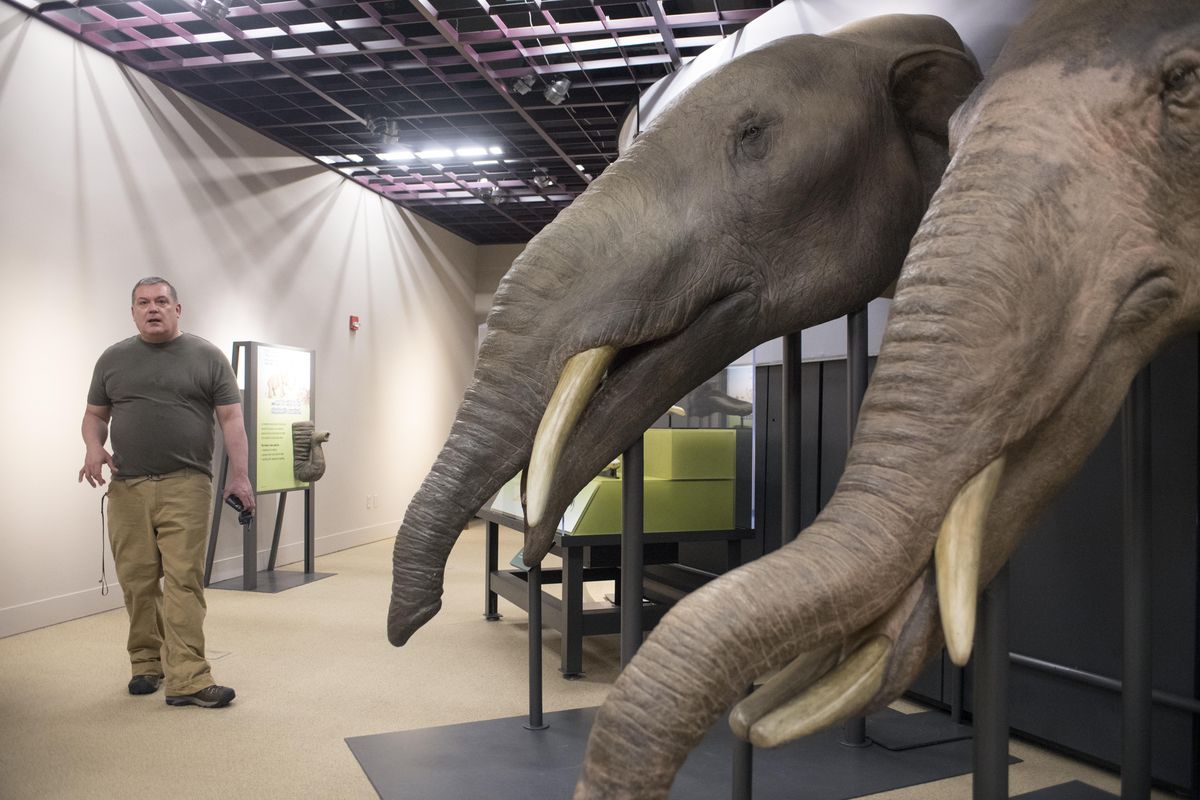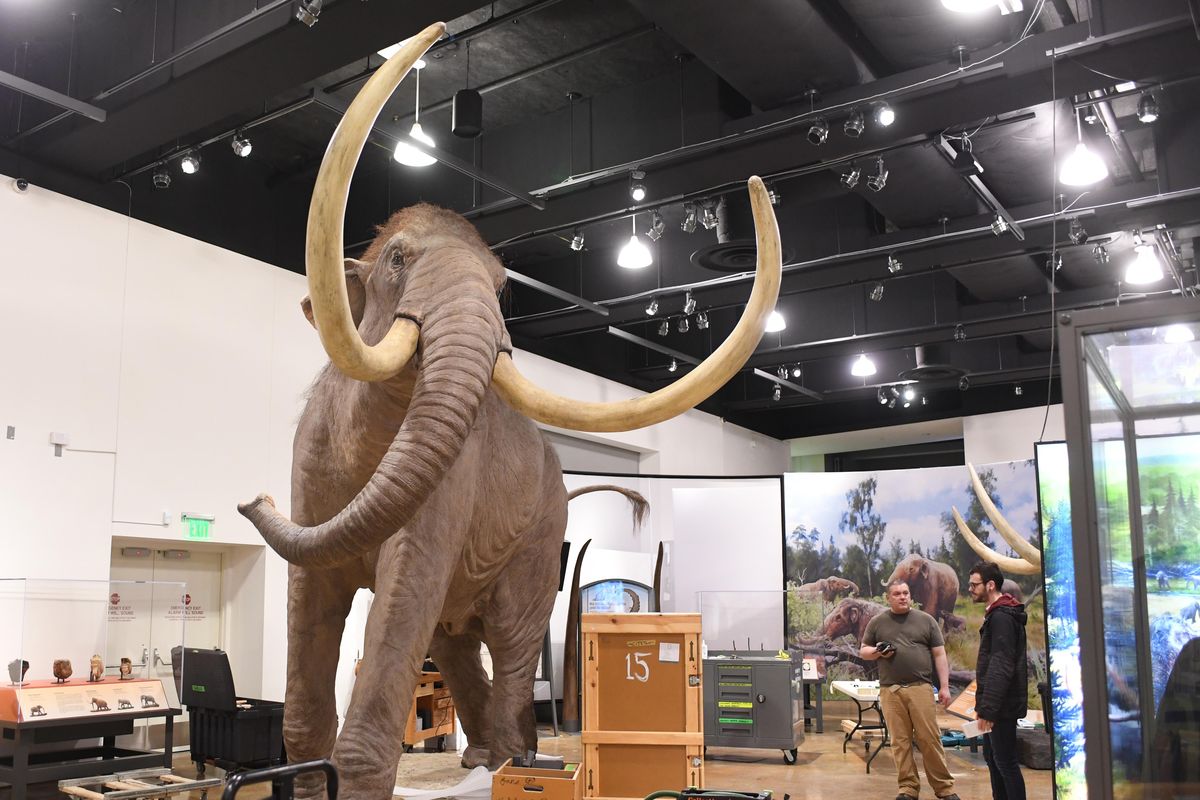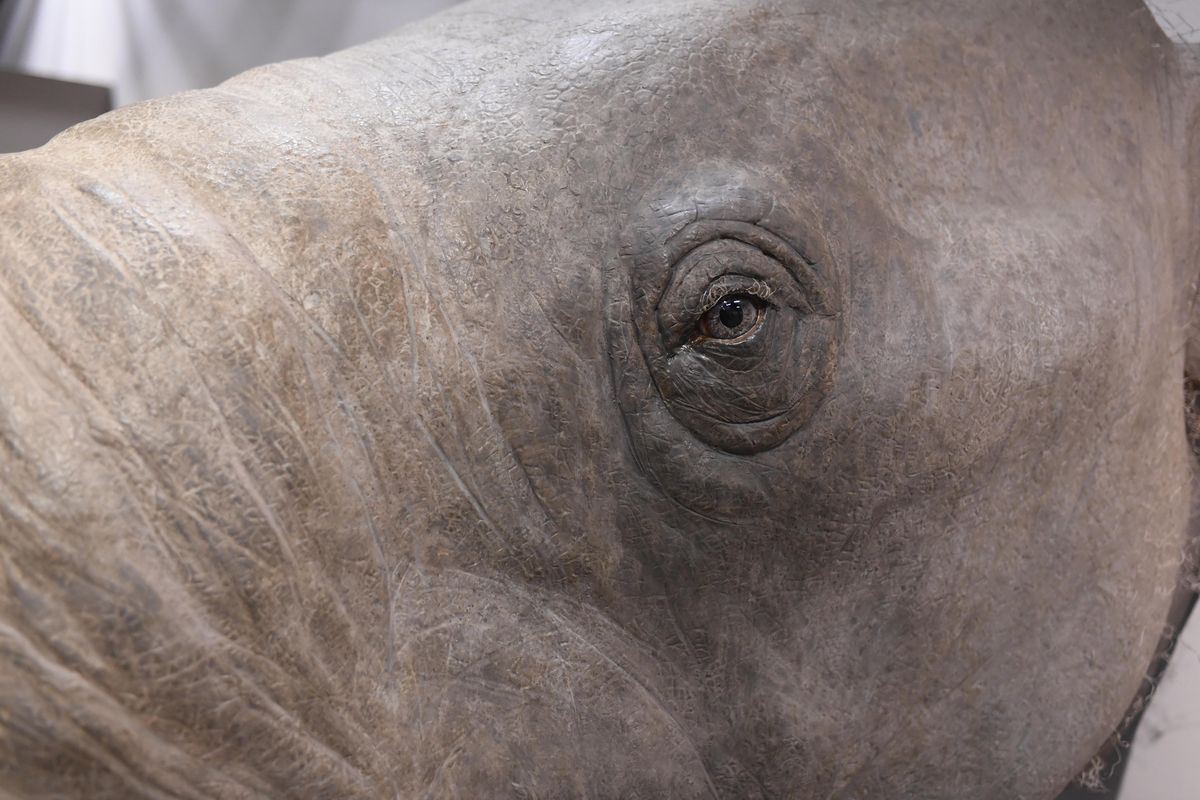March of the Mammoths: Ice Age beasts bring history alive in new Spokane MAC exhibit
A 13-foot replica of a Columbian mammoth dwarfs everything else in the main room of the Northwest Museum of Arts and Culture as staff prepare the exhibits for “Titans of the Ice Age,” a large exhibit from the Field Museum of Chicago, shown Monday. (Jesse Tinsley / The Spokesman-Review)Buy a print of this photo
John Moredo-Burich, director of the Northwest Museum of Arts and Culture, loves mammoths.
“I have an anthropomorphic affinity for them,” he said with a straight face.
To the layman, that means he appreciates how similar mammoths are to humans – in the way they’re built, with longer arms and defined shoulders, and in their pronounced molars with multiple ridges, which are perfect for chewing plant material.
Moredo-Burich isn’t alone. Of all the extinct creatures in the animal kingdom, perhaps one more than any other holds a special place in mankind’s heart: the woolly mammoth.
“There’s a lot of enthusiasm for knowledge of the ice age and new information on animals like mammoths and mastodons,” said Daniel Fisher, a paleontologist and professor at the University of Michigan. “This includes the woolly mammoth.”
It’s no wonder, then, that mammoths (and mastodons) are taking center stage this weekend in the MAC’s newest exhibit: “Titans of the Ice Age: Mammoths and Mastodons.” Everything from mammoths to mastodons to sabre-toothed cats, and even towering short-faced bears, will be on display. If it lived (and died) during the most recent great ice age from 1.8 million to 10,000 years ago, chances are this exhibit has it.
“This is a huge deal that hasn’t been here before,” Moredo-Burich said while showcasing the large, half-finished displays Monday ahead of the show’s opening on Saturday.
“Altogether, I think this is something significant for Spokane,” he said.
Hangman Creek Mammoth discovered in 1876
Fisher, who was the original curator for the exhibit when it debuted at the Field Museum of Natural History in Chicago, has spent most of his adult life studying the remains of long-dead creatures, and it’s that background that helped make the exhibit what it is.
Naturally, his work has shifted to the mammoths and mastodons still hiding underneath our feet, waiting to be discovered. For 30 years it’s been his main emphasis as he travels the world, excavating their remains and studying their storied past with humans.
And even though scientists have been digging up these creatures for centuries, it’s only now that we’re really starting to understand their actual lives, Fisher said.
“Their diets, their rates of growth, their age, their health status, the climate where they lived and other aspects of the nature of their environment – we’re using all of that to address in more detail than we ever did before,” he said. “Although everyone doesn’t agree today, I think we’re on our way to a much more thorough understanding.”
The Spokane area has seen its fair share of mammoth discoveries. Notably, the Hangman Creek Mammoth – the first Columbian mammoth bones ever discovered in the Inland Northwest – was recovered in 1876 from a bog near Hangman Creek in modern-day Latah, about 35 miles south of Spokane.
But it’s the remains of a baby mammoth on the other side of the world that has Fisher and other scientists – and especially Moredo-Burich – excited.
Named Lyuba, this 41,800-year-old female mammoth was found in Siberia in 2007. She’s easily the best-preserved mammoth ever recovered, and her remains have provided information about why mammoths became extinct in the first place.
“She’s so fresh that when they did an autopsy, she had 432 species of plant material around her and mother’s milk in her stomach,” Moredo-Burich said.
Climate change, hunting, or aliens?
Paleontologists don’t agree why mammoths and mastodons aren’t still wandering around like elephants.
There are four general schools of thought: they died as a consequence of climate change; a disease swept through their ranks; they were killed off by hunting and environmental stress caused by humans; or it was aliens.
Fisher puts credence in two of those theories – climate change and hunting – though he does appreciate the extraterrestrial-angle that some “still champion.”
“There’s very good evidence human hunting was a critical part of what caused the extinction,” Fisher said. “From what I see it was the most important factor. But in most contexts, I’m pretty cautious about saying that.”
The human-interference angle is an important point of focus for Moredo-Burich.
On the ground floor of the museum, next to a Columbian mammoth towering over the other exhibits, is a solemn display showcasing the realities of poaching of African and Asian elephants today.
“It’s horrible that what’s happening today,” he said. “They are not disappearing because of food; it’s because people are making trinkets out of them. It’s horrible.”
In addition to replicas, the exhibit also features real-life remains of mammoths, mastodons and giant ground sloths, some of them recovered here in Washington state (including a never-before-shown Columbian mammoth rib from the Coplen farm outside Latah – where the Hangman Creek Mammoth was found).
Moredo-Burich made it a point to focus on local digs and excavations. He wanted to highlight the region’s unique history with the animals, precisely because mammoths and mastodons were once the largest settlers of the land – long before man took that crown.
“We wanted this because of the enormity of the fossil finds and the skeletal remain finds in this area,” he said. “It’s important to show these.”



